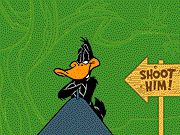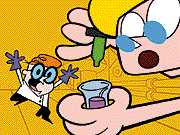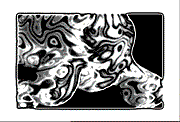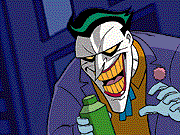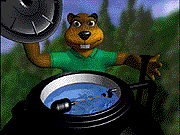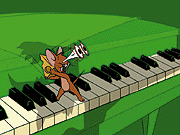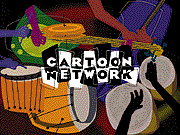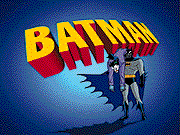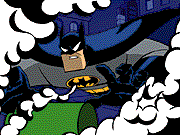DRAWN TO THE TECHNOLOGY...
Atlanta animators try to render "real-life" obsolete as they create new worlds via computer. Woody and Buzz, Mulan and her sidekick, and all those adorable spotted pups from the timeless classic 101 Dalmatians were computer images that came to life. When audiences think of full length animated feature films, names like Disney and Pixar immediately come to mind. Now that Marc Adler is entering the fray, however, might the current mindset ultimately be swayed? If the enthusiastic CEO of Atlanta based Macquarium Intelligent Communications has his way, his own in-house animation crew, Fathom Studios, not to mention a variety of other Atlanta animators, will come to mind.Fathom Studios is hard at work promoting an animated proof of concept to sell its first feature film, "Delgo: A Hero's Journey." The animated adventure, featuring a cast of computer generated characters which look like a cross between reptile and apes circa Planet of the Apes, proves once again that good can topple the forces of evil, and love can conquer all.
What it proves, too, at least to Adler and his crew, is that there's no reason full-feature animation can't be done, and done well, in Atlanta. "I believe," Adler says, "that a film like "Delgo" will open up possibilities for Atlanta animators. The concept was derived here, the animation was created here, and the voice talent is local. If you prove you can do it once, there's no reason you can't do it again."
While few companies are interested in creating full-length feature animation projects, Macquarium is far from alone in its quest to take on New York and Hollywood, and obtain a bigger piece of the animation industry pie. "There are three things that need to happen for Atlanta to gain greater recognition as an animation town," Adler remarks. "There has to be a technology infrastructure in place, an educational system that supports hi-tech, and on-going research done by individuals who can be pioneers in the field. It's happening here, even if right now it's only in pieces and pockets."
THE INDUSTRY MAKE-UP...
From corporate to broadcast and web design to film, Atlanta's animation shops appear to be keeping busy. Essentially there are three types of firms offering animation services; those companies which do nothing but animation, those which provide animation as part of an overall turnkey production service approach, and post-production houses which offer animation as an editing bonus.
NICHE PLAYERS...
While most companies in town go after a variety of work, two shops have taken a more focused approach to animation.While Doug Grimmett maintains enough computer trained staff to bring his characters and objects to life, traditional cell animation is, and always will be, the name of the game at Primal Screen. Claiming his is the largest cell animation house in the Southeast, a portion of Grimmett's crew whiles away the day determining their characters' next moves, while other team members spend the day inking in the lines of those characters so they can be scanned into the computer. "A lot of what we do", Grimmett notes, " is re-animate characters for the Cartoon Network which haven't been animated in 30 or 40 years. I had started this business in Chapel Hill, but when the Cartoon Network moved to Atlanta, I suspected they might need some on-going help and moved the business here."
With his master's degree in aerospace engineering from GA Tech, Rob Abbanat, President of Engineered Multimedia, Inc., always assumed he'd work for a major corporation like Boeing. He did, in fact, receive a job offer from them following graduation. Instead, he found himself developing engineering textbooks for CD ROM's, which led to the chance and very fortuitous meeting with a project manager for NASA's Pathfinder Mission to Mars. The twelve-minute animation that helped viewers around the world witness the momentous space journey propelled Abbanat's fledgling business to the next level. He smiles, "That original launch was pretty crummy compared to what we can do now. With engineers and animators on staff, our main focus is creating high-end animation for the science and engineering community that's technically accurate. Our clients include Beers Construction, MIT, and CNN Interactive. We'll be doing another launch with NASA in December and we're hoping to create an animated special on Comets. It's pretty exciting."
ANYONE CAN BE AN ANIMATOR...
Thanks to lower computer costs, any knucklehead with a nearby Kinko's can be a production company according to one anonymous source. And that's something that can leave uneducated clients with a bad taste in their mouths. "There's a degree of artistry involved in animation," comments Kevin Christopher of AGI Studios. It's not just about plugging in software. You need to be part physicist, engineer, sculptor, motion poet, and architect. We worked with one client who had been strung along by a kid with a computer for several months. It turned out he was in way over his head. We ended up taking the project on."
THE GREAT SOFTWARE DEBATE...
Is one software package better than the next? Ask 5 different animation shops and you could get five different answers. According to individuals like Athalie White from Click 3X and Rob Taylor of Crawford Communications, Alias Wavefront's newest software "Maya" is the hottest, greatest software currently available. "Animating the human figure had always been extremely difficult," notes Click 3X's White. "There are some 47 different positions for the mouth responsible for different sounds. îMaya' has made the process much easier."According to Kevin Christopher, owner of AGI Studios, "3D Studio Max" is the most cost-effective software currently on the market. "If you compare packages," he cites, "they all have similar features, but one is $3,500, for example, versus $20,000 per single license." Adds brother Ty, "With î3D Studio Max' we can still produce high quality work and pass down the savings to our clients."
Eric Deren of Dzignlight has invested in high priced "Soft Image," and supports his choice by saying, "Anybody can work with a hammer and screwdriver, but it's not necessarily the best way of doing things. îSoft Image' is about having a full toolbox. It's the difference between driving a pick-up truck and a Yugo. The Yugo will get you there, but it won't fit as much, or go as fast." While he is uncertain as to whether the expensive software is cost effective, he says, "I don't know if there is $17,000 worth of difference in the work I do, but you pay a premium for being out in front."
Freelance animator Madeline Baum disagrees with having to pay a premium for high quality work. "Even as recently as five years ago," she notes, "you needed an expensive work station like Silicon Graphics, which might cost $70,000, and then you had to purchase the software, which was also expensive. You could easily drop $200,000. But then people started developing software for the Mac and PC. Early on these softwares couldn't compete with the expensive packages but they've grown more powerful recently. Once upon a time, work done on a program like îSoft Image' would look glitzier. I use î3D Studio Max' now, and I believe it's difficult to tell the difference these days."
"Light Wave 3D" for Mac is the choice of Alex Burmenko, of Amitrace Video. "The M&M characters, for example, were created in Light Wave," he cites. And it was used for a space piece, which Tom Hanks did for Showtime. It may not be as powerful as îMaya,' but it's getting out there."
Whoa Film's Kevin Sargent currently uses "Soft Image," but is continually on the lookout for the latest, greatest version. "There's no doubt that staying on top of the technology allows you to get the job done to a higher degree." Something that Crawford's Taylor couldn't agree with more, adding "We're in the process of buying the top equipment. We've also just hired someone who will put all these tools together and create the plug-ins we need for those effects that seem to be impossible to create. True, the hardware and software are just tools, but the idea behind state-of-the-art hardware and software is so our artists don't have to spend 60% of their time making a tool work. We want to make the process as seamless as possible."
IT'S THE ANIMATOR NOT THE SOFTWARE...
While local animators may not agree about the best software tools, there is one thing they're in total agreement about. Says Karl Horstmann, of Triple Horse Productions, "There is a general misconception about 3D imagery. We all know there are many different platforms and software out there, but it's the guy who drives the ship that counts most." Jason Maurer, Creative Director of Animation for Macquarium's Fathom Studios adds, "The software is the tool that gives us the ability to put our imagination on the screen. If I have no imagination, it's worthless." "A great artist is going to shine no matter what he uses," Taylor believes. "But if you give him all the right tools, he may just blow your mind."
BELLS AND WHISTLES THAT SET THEM APART...
Talent undoubtedly drives a project, but there are a few bells and whistles which set apart two local firms. Until recent years, capturing realistic motion has been one of the most difficult and time-consuming tricks of the animation trade. Thanks to Biomechanics, Inc., a Marietta research and development company, which has gained national recognition for capturing and manipulating three-dimensional motion, the task has grown simpler. Crawford's Taylor can't contain his excitement over the fact that Crawford and Biomechanics have forged a working partnership, and just completed a motion capture stage at Crawford's facilities. Using sensors, the computer records motion input and creates a virtual 3-D map of a subject, which the animator can then manipulate depending on their needs. "If you want to take advantage of Biomechanics' motion capture equipment," Taylor says, "you can do so at Crawford. My hope is that this will help change the way Atlanta and Crawford are perceived."Macquarium also hopes to set itself apart technologically with its Cyberware Scanner. "We're one of only thirteen providers worldwide," Adler notes of the tool, which has raised the bar on accurately capturing the detail of facial features and three-dimensional objects. "Once an image is scanned, the Cyberware software can manipulate, texturize, color enhance, and add other effects that give the image a whole new life."
TAKING THE TRIP TO LA...
Local animation shops struggle, as do so many of their creative industry peers, with keeping local work in Atlanta. Says Steve Cocks of Wild Dog Studios, the animation arm of Big Mouth Effects, "A lot of agencies come to us with mid size projects, but the minute they get a big budget for an account like Nike, for example, they head out west. The problem is that the level of work on your reel reflects the budgets you're given and makes it difficult to compete for the higher budget work." "It's ironic," notes Lori Oliva, Macquarium PR Director, but the more national press we get, the more local opportunities seem to appear."
IN TOWN VERSUS OUT OF TOWN DOLLARS...
Macquarium's Adler may not be certain of the percentages, but most of his firm's work is generated out of town. "The greatest portion of our in-town work," says Click 3X's White, "comes from agencies like J. Walter Thompson, or McCann Erickson (now part of Fitzgerald & Company). Because it's relatively expensive, few local agencies use animation, which is why about 70% of our business is generated outside of Atlanta." While Crawford's Taylor would also like to see more Atlanta business, he doesn't hide the fact that his goal is to develop a national presence. "I just came back from a trip to New York where we showed our work to some large agencies. We want to grow outside of the city." Eric Deren of Dzignlight believes his is about a fifty-fifty, local vs. out-of-town split. Then there are those animators who work almost entirely from an Atlanta client base, such as AGI Studios and Stone Mountain Productions.
A FEW MISCONCEPTIONS...
The most difficult thing to explain to clients is how long a project will take when justifying its costs. "Sometimes you feel like the client thinks all you need to do is hit the "animation," or "looking good" button, and the job is done," says freelance animator Baum. "I'll joke with people and say you can have cheap, fast, or good. Pick two." Which is why Click 3X's White appreciates when agencies come to them first, before talking price with clients. "If we can be in on the first conversations, we can explain the time and costs involved. Too often, we have agencies come to us after they've already discussed price with their clients, and the project simply can't be done for the price they've quoted."
EARNING PRAISE FROM THE CARTOON NETWORK...
Like many of his peers Steve Carroll, Director of Marketing for Stone Mountain Productions, which for years has created Stone Mountain's well known laser show, believes that the arrival of the Cartoon Network has meant a boost for the industry. The Cartoon Network believes it's a boost the city deserves."When I first came to Atlanta from New York, I didn't think there was much going on here animation wise," comments Senior Vice President and Creative Director Michael Ouweleen. "Now I have to admit the talent pool has gotten much larger than I thought it could. There are some amazing things getting done here. While I'm not certain Atlanta has developed its own style yet, there are people out there who are using software in really neat ways. We will continue using people from various cities for various projects, but I don't hesitate to say Atlanta stacks up." Ouweleen believes Atlanta could just tip itself into being a recognized player in the animation game. "People," he remarks, "go to individual animation directors for their sensibility, timing, and personality. You don't go to a city per se. It's less about facilities than it is about the director. There is no bias against Atlanta. Atlanta animators simply need to develop recognizable names."
WHAT THE FUTURE HOLDS...
Unpredictable is the word most individuals use when looking at the future of animation in Atlanta. Macquarium's Adler believes a successful future depends on the generation of more original content. "As long as we're just a production facility for others," he says, "we won't grow much. We need to drive the content to gain recognition." Others like Crawford's Taylor believe that with the continued focus on talent and technology, the future will be bright. AGI's Kevin Christopher admits he simply doesn't know what's going to happen. "The market may have been saturated yesterday, and today it's wide open, but who knows what will happen tomorrow?"